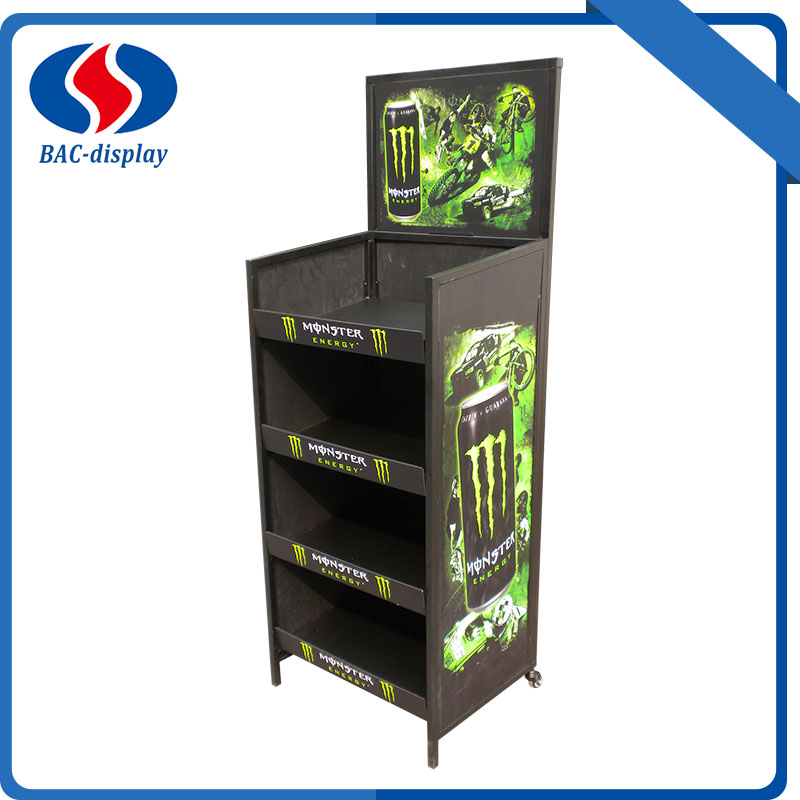Maximizing Retail Impact with Floor Displays: The Key to Boosting Sales
2025-01-04
In the fast-paced world of retail, attracting customers and encouraging impulse buys is essential for driving sales. One of the most effective tools for achieving this is the floor display. These visual merchandising fixtures are designed to catch the eye, organize products, and make it easier for customers to browse. Whether in a supermarket, fashion store, or electronics shop, floor displays play a pivotal role in creating a memorable shopping experience. In this blog, we’ll explore the importance of floor displays, the different types, and how to use them effectively to boost sales.
What is a Floor Display?
A floor display is a freestanding display unit placed directly on the retail floor to showcase products. Unlike shelves or wall-mounted fixtures, floor displays are typically mobile and can be positioned anywhere within a store. These displays are designed to stand out and grab customers' attention, often featuring a combination of eye-catching visuals, product arrangements, and signage.
Floor displays serve a dual purpose: to present products in an organized and appealing manner while also guiding the customer's attention to specific items. They can be temporary or permanent, depending on the retail needs, and they are often used for seasonal promotions, new product launches, or clearance sales.
Why are Floor Displays Important?
Floor displays play an essential role in shaping the shopping experience and influencing purchasing decisions. Here's why they are so important:
1. Increased Visibility: Products displayed on the floor are more likely to be noticed by shoppers, especially in high-traffic areas. A well-designed floor display ensures that featured products stand out from other merchandise on the shelves.
2. Impulse Purchases: Strategic placement of floor displays can trigger impulse buying. By highlighting popular, discounted, or seasonal items, stores can encourage customers to make additional purchases they hadn’t planned on.
3. Branding and Storytelling: A floor display offers an opportunity to reinforce a brand’s identity and tell a story. Custom graphics, logos, and thematic displays help communicate the brand's values, style, or product features, which can resonate with customers on a deeper level.
4. Better Organization: Floor displays are often used to group similar products together, making it easier for customers to browse. This organization leads to a more efficient shopping experience and can drive greater sales volume for specific product categories.
5. Enhancing the In-Store Experience: Floor displays help create an engaging, interactive experience for customers. By drawing attention to specific products in a creative way, stores can make shopping more enjoyable and memorable.
Types of Floor Displays
There are several different types of floor displays, each suited to different retail environments and products. Some of the most common types include:
1. Endcap Displays: Endcaps are floor displays placed at the end of store aisles. They are among the most visible display types, offering high exposure to customers as they walk through the store. Endcap displays are perfect for promoting new items, seasonal products, or sales.
2. Dump Bins: These are large, often open bins placed on the floor and filled with discounted or clearance items. Dump bins encourage customers to dig through the contents and find great deals. They are perfect for low-cost or impulse-buy items.
3. Floor Stands: Floor stands are freestanding units designed to display specific products, such as small electronics, beauty items, or accessories. These displays are usually compact and can be placed in high-traffic areas to attract attention.
4. Pallet Displays: Pallet displays are large, typically made from wood or cardboard, and are often used for bulk products or promotional items. These displays are ideal for showcasing large quantities of items at a discounted price.
5. Interactive Displays: Some floor displays are designed to encourage customer interaction. For example, touchscreen displays that allow customers to learn more about a product or promotions. These displays can be particularly effective in technology, gaming, and beauty retail sectors.
6. Pedestal Displays: Pedestal displays are elegant, often used in fashion and jewelry stores to display high-end or featured products. They raise products to eye level, making them more noticeable and desirable.
7. Modular Displays: Modular displays can be reconfigured to meet the changing needs of a store. These versatile systems allow retailers to adjust the display size, layout, and functionality based on the store’s current product offerings.
How to Create an Effective Floor Display
While floor displays can be a powerful tool for increasing sales, their effectiveness depends on how well they are designed and executed. Here are some tips for creating a floor display that will drive traffic and boost sales:
1. Consider the Location: Placement is key to a successful floor display. Ensure that the display is placed in high-traffic areas where it will catch the attention of customers. End of aisles, near entrances, or next to checkout counters are prime spots.
2. Keep it Simple and Organized: Avoid overcrowding the display with too many products. A clean, organized display is easier for customers to navigate and will make your featured products stand out more. Use dividers or shelves to keep items neatly arranged.
3. Use Bold Graphics and Signage: Good signage can make a huge difference. Include clear, bold messaging about promotions, discounts, or product features. Bright colors, large fonts, and attractive visuals can draw customers in and make the display more engaging.
4. Highlight Bestsellers or Seasonal Items: Promote your bestsellers, limited-edition items, or seasonal products in floor displays. Positioning these items at eye level or in prominent spots will make them more attractive to customers and increase the likelihood of a purchase.
5. Make It Interactive: If possible, incorporate interactive elements such as QR codes, digital screens, or product samples. Allowing customers to engage with the display helps them connect with the product and makes the shopping experience more enjoyable.
6. Use Lighting to Enhance Visibility: Proper lighting can elevate a floor display. Highlight your display with spotlights or LED strips to ensure it stands out, especially in dimly lit areas of the store. Proper lighting can also create an inviting atmosphere.
7. Change Displays Regularly: Keep things fresh by rotating the products and themes of your floor displays. Regular updates will keep the displays relevant and maintain customer interest over time. Seasonal updates can also align with holidays or special promotions.
8. Ensure Stock Availability: A well-stocked display is essential. Customers may be disappointed if they find an empty display or limited quantities. Keep the display filled to meet demand, especially for popular products.
The Bottom Line: The Power of Floor Displays
In a retail environment where customers are constantly bombarded with choices, floor displays are an excellent way to capture attention and increase sales. By strategically placing products, using eye-catching designs, and keeping the display fresh and relevant, retailers can encourage customers to make impulse purchases and enhance their overall shopping experience. Floor displays not only drive sales but also contribute to the brand image, create excitement in-store, and ultimately play a critical role in building customer loyalty.
Whether you're promoting a new product, running a seasonal sale, or simply organizing your store, investing in effective floor displays is an essential step in maximizing retail success. The right display can turn a casual shopper into a committed buyer—and in the competitive world of retail, that's what truly matters.



